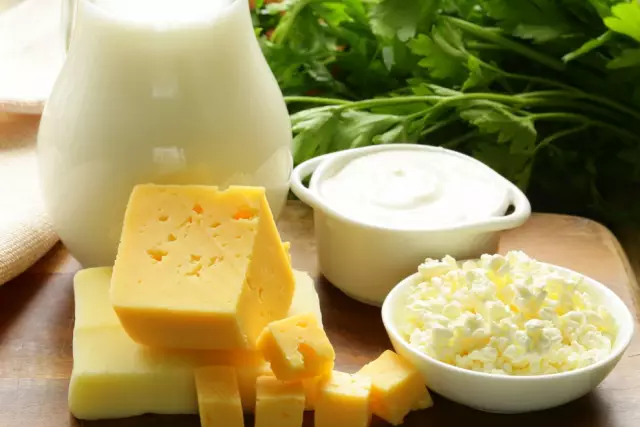- Author Rachel Wainwright [email protected].
- Public 2023-12-15 07:39.
- Last modified 2025-11-02 20:14.
Slimming milk
As a valuable source of protein and calcium, slimming milk is used in many types of diets.

What is the use of milk for weight loss?
Milk is a valuable nutritious animal product. It contains about 30 different mineral salts, 20 vitamins, 25 fatty acids, 22 types of amino acids. Such a rich composition makes it possible to recommend milk for weight loss, because the calorie content of this product is low.
The mechanism of weight loss when using milk for weight loss is mainly associated with the effect on calcium metabolism. This product contains a lot of active calcium in the form of various salts. Calcium ions affect the amount of the hormone calcitriol produced in the body, which can not only regulate mineral metabolism, but also prevent the formation of excess fat in the body.
According to reviews, milk for weight loss saturates the body well and suppresses hunger. The load on the digestive system when drinking milk is insignificant, and the calorie content in it is low, which is why milk for weight loss is just perfect.
Calorie content of different types of milk
The composition and calorie content of milk is a variable value, they may differ slightly depending on whether it is cow's or goat's milk, homemade or store milk, dry or concentrated.
First of all, the calorie content of milk depends on its fat content - that is, on the percentage of fat in the product.
On average, the fat content of cow's milk ranges from 3.6 to 4.2%. It is influenced by various factors:
- Season;
- Breed of animals;
- A variety of feed, etc.
If a higher fat content is indicated on the milk package, then most likely vegetable or animal fats have been artificially added to the milk. In standardized milk, cream is present as an additive.
The calorie content of homemade milk with a fat content of 3.2% is 58 kcal per 100 g of drink, and 3.5% - 61 kcal per 100 g. If the fat content is 2.5%, then the calorie content of homemade milk will be 52 kcal.
The calorie content of goat milk, like that of sheep's milk, is slightly higher. In composition, it is the closest to that of a human. The calorie figures for goat milk are close to 68 kcal per 100 g.
Powdered milk is a concentrated product. It is obtained by drying pre-condensed milk, so the calorie content of milk powder is higher than that of ordinary milk. If we talk about specific figures, then the calorie content of skimmed milk powder is 373 kcal per 100 g of powder, whole milk powder - 549 kcal per 100 g of powder. But milk powder for weight loss, according to reviews, is suitable if you drink it or add it to food diluted, and not consume this high-calorie product in dry form.

The calorie content of baked milk differs from that of whole milk. In the process of reheating, part of the liquid evaporates, and the product becomes more concentrated and fatty. The calorie content of baked milk per 100 g is 84 kcal.
Diet with milk for weight loss
To normalize weight, it is recommended to consume 2-3 glasses of whole milk per day. Milk normalizes metabolism and prevents excess weight.
It is believed that in an adult state, milk is less digestible and that it can only be included in the diet for children. This is due to the lack of the enzyme lactase, which digests milk sugar. In fact, you just need to gradually increase the volume of milk consumption, and then the intestinal enzyme system gradually adapts to this product.
A person may have an individual milk intolerance, which is manifested by allergic symptoms, as well as disturbances in the functioning of the digestive system. In these cases, you cannot use milk for weight loss.
Found a mistake in the text? Select it and press Ctrl + Enter.






